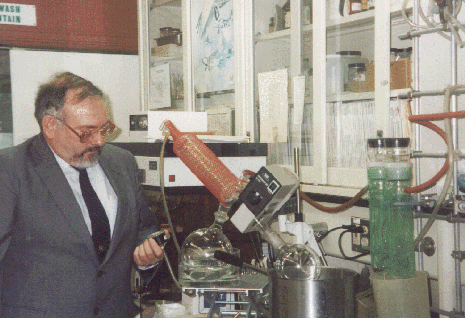 |
|||||
| Home | Research | For Teachers | HISTORY Level 1 Level 2 Level 3 |
PRINCIPLES Level 1 Level 2 Level 3 |
CAREER Level 1 Level 2 Level 3 |
| Gallery | Hot Links | What's New! | |||
| Web Administration and Tools | |||||
 |
|||||
| Home | Research | For Teachers | HISTORY Level 1 Level 2 Level 3 |
PRINCIPLES Level 1 Level 2 Level 3 |
CAREER Level 1 Level 2 Level 3 |
| Gallery | Hot Links | What's New! | |||
| Web Administration and Tools | |||||
![]()
In response to the need for processable high-temperature-resistant polymer-matrix materials, Army and NASA Lewis investigators developed a new class of polyimides known as PMR (polymerization of monomeric reactants). Since the PMR concept has been adopted commercially, processing materials, molding powders, chopped-fiber-molding compounds, and adhesives employing PMR-15 (first-generation PMR-type resin) are now available commercially from major suppliers of aerospace composite materials. The excellent high-temperature mechanical properties, superior thermo-oxidative stability, easy composite processability, and ready availability have led to the wide acceptance. For example, PMR-15 is being used to fabricate a variety of engine components ranging from small, compression molded bearings to large, structural autoclave-molded engine ducts used on the F404 engine for the Navy F-18A Hornet. Thus, in less than a decade, PMR-15 went from the initial idea stage and a U.S. Patent to being the bill of material for production items in military turbojet and turboshaft engines.
In the second decade of PMR-15 technology transfer, additional examples of engine applications were identified in gear box covers, transmission housings, inlet particle separators (General Electric T700), vent tubes (General Electric - 90), fan stator and vane assembly (General Electric YF-120), external exit flaps (Pratt and Whitney F100-229) and core cowls (General Electric CF6-80A3). At the same time, PMR II resins (second generation PMR type resin) was invented for higher temperature composite engine components. This was quickly followed by the modified PMR II resins, high molecular weight PMR II-50 and vinyl cured PMR II resins as UCAP-75. These resins are currently undergoing successful technology transfer to engine manufacturers for higher temperature engine applications such as fairings, compressor cases and spinner cones. Thus, after twenty years of technology transfer, PMR remains as the state-of-the-art in processable, commercially available, high temperature polymer matrix resins for many aerospace applications, many of which are military and commercial engine components.
POC: Dr. William B. Alston

Conducting tests on polyimide composites.
![]()
Send all comments to ![]() aeromaster@eng.fiu.edu
aeromaster@eng.fiu.edu
© 1995-98 ALLSTAR Network. All rights reserved worldwide.
Updated: February 17, 1999